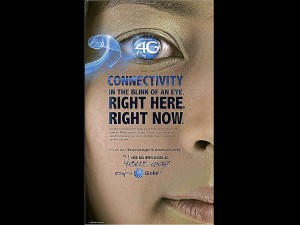
Your mom is falling in line at the supermarket. You’re waiting for your turn at a mall theater ticket counter. Your sister is waiting for the gang at the university cafeteria. Your girl friend is lounging near the beach. Imagine all of you watching your favorite YouTube videos in full sight and sound splendor—with no irritating lag and buffering.
High-speed mobile web browsing, better multimedia uploads, faster streaming and downloads, imagine no more.
With 4G-mobile technology, Filipinos can now enjoy an unprecedented high-speed and hassle-free broadband connectivity. Globe, the first to roll it in the country, launches this amazing technology as a major expansion of its current 4G footprint.
Utilizing the global standard HSPA+ or Evolved High-Speed Packet Access for its 4G mobile network, Globe complements its current 4G WiMAX (Worldwide Interoperability for Microwave Access) network for unprecedented broadband connectivity experience for all.
Sounds greek to you? Let’s get to know 4G-mobile technology from a layman’s point of view:
Difference between 3G and 4G
4G mobile is a newer set of technologies compared with the 3G customers are familiar with today.
This provides significant service improvement over the current 3G, giving subscribers faster, better broadband and web surfing enjoyment. Customers are then able to download more contents in same amount of time.
As connections are consistently reliable, stable, and making real-time applications, such as VoIP, video streaming, gaming, and others possible, a new level of broadband experience is reached.
How is 4G mobile relevant to a consumer who is not techno-savvy?
4G means super fast broadband and web surfing fun (previously, Globe launched 4G Wimax to enable customers to enjoy high-speed broadband at home). With the new 4G HSPA+mobile network, Globe sets the high-speed broadband capabilities further—allowing customers outside their homes to enjoy high-speed access from their mobile phones and laptops.
What is 4G-mobile technology to someone who has the latest mobile phone and laptop?
If you have a 4G-enabled device, such as the Samsung Galaxy S2, you will experience 4-6 times increase in speed over 3G, typically in the 5-10mbps range, with bursts of 15mbps. Higher speeds are quoted for both HSPA+ and LTE.
How does that relate to the 5-10mbps mentioned above?
Theoretically, HSPA+ and LTE (Long Term Evolution) have quoted download speed of 84mbps and 100mbps, respectively. However, these are speeds that are achieved in ‘lab settings’ with optimal conditions for all aspects. In the real world, and under normal conditions, both HSPA+ and LTE will typically deliver speeds in the range of the 5-10mbps as mentioned above.
The dramatic difference between HSPA+ and LTE
There are three main technology standards under 4G: Wimax, LTE, and HSPA+. Each one has its own pros and cons. For example, Wimax is very good for delivering home broadband, but not for mobile devices.
LTE is a bit faster than HSPA+, but is not ‘backward compatible’ so only new 4G devices can feel the benefit of LTE. Though not as fast as LTE, HSPA+ is ‘backward compatible’ with 3G, meaning that the large base of customers with 3G handsets will feel the benefits from an HSPA+ rollout.
Because Globe is focused on what customers are asking for, all these three technologies are all rolled out for their enjoyment.
What does HSPA+ backward compatible mean? Why is it named backward?
As mentioned earlier, 4G/HSPA+ technology allows existing Globe customers with 3G handsets to enjoy an improvement in call, text, and data services—not just those that can immediately invest in a new 4G handset. As such, 4G/HSPA+ technology works ‘backward’ to include existing 3G users in its benefits, while at the same time enabling new capabilities.
First to rollout 4G Wimax in the Philippines in 2009, Globe paved the way to a convenient and affordable way for Filipino consumers to access high-speed broadband from the comfort of their homes. It has now one of the largest deployments in Southeast Asia, to meet customers’ need for an inexpensive and flexible home broadband solution.
What does ‘largest WiMax deployments in Southeast Asia’ mean?
Globe’s 4G WiMax deployment for high-speed broadband at home is one of the largest in the region in area size (1,800 sites throughout the country). Subscribers that have availed since then has jumped to 200,000.
Now that it is the first to roll out HSPA+, customers with 3G devices can now immediately experience Globe’s improvements in call, text, and data services.
And finally, committed to roll out LTE by 2012, in time for mass availability of devices, it will allow subscribers to actually enjoy LTE.
Globe’s HSPA+, a technology that’s already available to subscribers in the country, has also been deployed in 19 sites in Metro Manila. Thus, 2G/3G subscribers based in these sites can now experience significant improvements in calling, texting, and mobile surfing, while expansion to more areas and sites is ongoing.
Most common broadband experiences
We see customers using broadband today, primarily for net surfing and social network interactions (Facebook, Twitter, etc.).
With 4G-mobile, this uptrend is expected to continue, and Globe is committed to expand more with advanced types like VoIP calling, video streaming, gaming, and other valued added services, things you previously thought were only possible from home.
What celfones are 4G enabled?
Globe will be the exclusive launch carrier of an amazing mobile phone, the Samsung’s Galaxy S2. Additionally, it’s not just mobile phones that are 4G- enabled, it will also launch dongles and MyFi devices from Huawei and ZTE.
These devices will enable customers to also enjoy full 4G experience on their laptops throughout many locations in Metro Manila where 4G is rolled out, and soon in many other parts of the country.
What do you mean by ‘improved lower latency’?
In layman’s term, 4G/HSPA+ removes small, almost imperceptible delays that occur in normal communication services people use today. This is critical in enabling new real-time services such VoIP and gaming, where those small delays would previously, prior to 4G, have translated to noticeable impact.